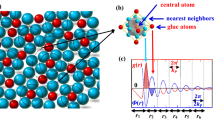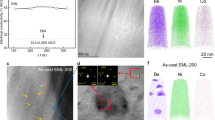Abstract
IT is a well-known fact that the concentration of alloying elements in the scale formed on heating an alloy in air differs in most cases considerably from the average composition of the material. The product of high-temperature oxidation of brass, for example, consists of zinc oxide only. At lower temperatures cuprous oxide is the prevailing constituent1, Iitaka and Miyake found nothing but BeO on the surface of copper-beryllium alloys containing so little as 1 per cent of beryllium. Copper-aluminium alloys with several per cent aluminium content, heated with a Bunsen burner, gave Al2O3 in places which had been embedded in the flame, while CuO was found on those parts of the surface which had been in contact with air2.
This is a preview of subscription content, access via your institution
Access options
Subscribe to this journal
Receive 51 print issues and online access
$199.00 per year
only $3.90 per issue
Buy this article
- Purchase on SpringerLink
- Instant access to full article PDF
Prices may be subject to local taxes which are calculated during checkout
Similar content being viewed by others
References
Dunn, J. S., J. Inst. Met., 46, 25 (1931). Preston and Bircumshaw, Phil. Mag., 20, 706 (1935). Krupkowski and Jaszczurowski, Rev., Met., 33, 652 (1936) and others.
Iitaka, I., and Miyake, S., NATURE, 136, 437 (1935) and 137, 457 (1936).
See, for example, Adam, N. K., "The Physics and Chemistry of Surfaces" (chapter iv).
Desch, C. H., "The Chemistry of Solids", p. 53.
Dobinski, S., Phil. Mag., 23, 397 (1937).
Author information
Authors and Affiliations
Rights and permissions
About this article
Cite this article
DOBINSKI, S. Adsorption of Constituents of a Solid Phase on the Surface. Nature 141, 81–82 (1938). https://doi.org/10.1038/141081c0
Published:
Issue date:
DOI: https://doi.org/10.1038/141081c0
This article is cited by
-
Behaviour of Al-Mg alloys at high temperature
Journal of Materials Science (1987)
-
Selective Oxidation of Aluminium Alloys
Nature (1939)



